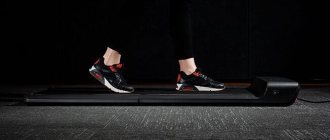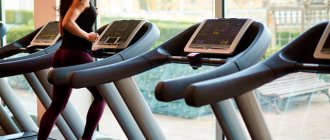Every year, the cult of a beautiful and healthy body is established in different countries, so various exercise machines are becoming increasingly popular.
The most popular is the treadmill, since it imitates the most natural load for a person - running.
Thanks to technological progress, such exercise machines are now high-tech and have an excellent shock absorption system that removes the shock load from the legs. Let's look at the most basic factors about training on modern treadmills.
Content
- Safety is the most important thing on the treadmill.
- How effective is treadmill training?
- Monitoring Treadmill Performance
- Treadmill training program
The treadmill is a great solution for cardiovascular exercise throughout the year, regardless of the weather. This article is a practical guide to running a treadmill workout.
Although exercise machines may be perceived as boring, most models come with a huge variety of different features and programs to develop your physical abilities. Treadmill features include some of the following:
- Variable speed and angle of ascent/descent
- Pre-established training programs
- Built-in cooling fans
- Heart rate monitoring
- Fitness test
In addition, some models have monitors, so you can always watch your favorite show while working out. The classes will definitely not be boring, because in addition to new high-tech tools, there are also different modes of operation:
- Steady pace throughout your workout
- Hill Climb Training
- Speed interval modes
- Smooth tempo modes
What is the effect of increasing the angle of inclination?
Angle adjustment is a popular option in both inexpensive treadmill models and the most modern versions from the world's leading brands of sports equipment. Only in mechanical and magnetic cardio trainers is it adjusted manually, and in multifunctional electric ones – using the on-board computer. The angle can be from 6 to 15 degrees.
Like changing the speed of movement, adjusting the angle of inclination of the canvas affects the level of load - going uphill increases it many times over. At the same time it helps:
- give variety to the workout (especially by turning on the “Hills” program, which simulates not only going up, but also going down by alternating changes in the position of the track);
- increase endurance - returning to your previous runs in a straight line will immediately make you feel how much more difficult it is to run at an angle;
- in addition to aerobic, include a strength element of training, which requires tension not only of the muscles, but also of the ligaments and joints of the legs.
- increase coordination – the biomechanics of lifting are quite complex and require coordination of movements;
- due to increased load, burn more calories in a given unit of time.
The higher the inclination, the greater the stress on the calf and thigh muscles, as well as on the shoulder girdle - a natural need arises to intensively help yourself with your hands.
Peculiarity! By increasing the incline angle by just 5% from the standard position, you will save an additional 100 calories.
It is strongly not recommended to use the incline during pregnancy, the elderly and beginners.
Safety is the most important thing on the treadmill.
Working out on a treadmill is a safe activity, but a momentary loss of concentration can lead to trouble, so before you begin, follow these guidelines:
- Emergency stop
. Many treadmills have a safety cord that you can attach to your clothing. The opposite end of the cord is attached to the emergency stop button and will turn off the machine if you move too far from the front panel. Simply attach the cord to your clothing at the start of your workout. - Wait for the belt to stop
. Never sit on a treadmill while the belt is moving. Always wait for it to stop before dismounting, and likewise, never jump on a moving treadmill. - Control your position on the track
. Try to stay in the central part of the moving surface, and not close to the control panel. However, make sure you can reach the controls without difficulty. - Stay focused
. Walking and jogging are all great ways to relax, but you still need to stay focused to avoid slipping. If you enjoy listening to music, make sure it doesn't interfere with your concentration! - Determine your running pace
. Speed training on a treadmill can be very effective, but make sure the speed you reach is within your capabilities for the duration of the session.
Increase the effectiveness of your exercise bike workout
Adjust your seat height before you start so that your leg can reach the pedal freely as you move down.
The thigh muscle is tense when the leg goes down and relaxed when it goes up.
If you want to build muscle, use high resistance; if you want to reduce weight, use medium resistance.
Intensity depends on speed:
- light 15 km/h;
- moderate 22-25 km/h;
- high up to 30 km/h.
Monitoring Treadmill Performance
When you're running down the street, nothing more than an occasional glance at a store window will help you control and improve your technique. If you place a treadmill next to a mirror, you can constantly monitor your gait, posture, tension, stride length and knee lift - almost every movement you make.
Power walking, jogging and running are all simple activities, but it's no coincidence that elite runners spend many hours training to run smoothly and at the same time very quickly. By focusing on one thing, such as arm movement or overall posture, you can train your mind and body to run more efficiently.
Effective technique is often referred to as “running economy,” or running with a minimum of unnecessary movement. This saves energy and improves results. Try the suggested training program to learn how to properly distribute your forces.
Circuit training
If you just get bored with running, you can give yourself a full-fledged circuit training session. In 40 minutes you will burn many more calories than if you just ran. The most important rule is not to rest!
Run
Duration:
10 minutes.
Photo: istockphoto.com
We run them at a pace that is comfortable for us, without raising our heart rate to the limit.
If you have problems with a 10-minute run, you can replace it with interval running. We walk calmly for two minutes and run for two minutes. In this case, aerobic exercise lasts the same 10 minutes, without changes.
Circuit training with expanders from the absolute world champion in bodybuilding
Squats
After cardio, we don’t rest and immediately go to the barbell.
- We place our legs shoulder-width apart, feet parallel to each other.
- We place the bar on our shoulders and bend our legs to a right angle, keeping our back straight.
- The head does not drop, the gaze is in front of oneself. We work with a weight that is difficult for 10 repetitions.
We perform squats 10 times.
Photo: istockphoto.com
Tip #1: Eat the elephant piece by piece
The most terrifying and difficult part of running indoors is visualizing the long, monotonous process. Instead of thinking about your workout as a whole, break it down into short chunks (like 25 minutes) and create a routine for each chunk. This could be a change in speed or incline. Before you start a long workout, make a list of your entertainment options for each period of time.
Example:
- 25 minutes. Each mile, increase your pace and run at a fast pace for 30 to 60 seconds, then return to your original pace.
- 50 minutes. Focus on your inner sensations, listen to your body and mentally walk through it, tasting the sensations in every centimeter of your body from top to toe. This will help shift your focus and distract you from monotonous running.
- 75 minutes. Every mile, increase the incline of the treadmill by 2-3%. This will change the load (involve additional muscles in the work) and will be very helpful if the marathon is held on hilly terrain.
When and how often can you do cardio training?
The most important thing is that such workouts perfectly load the muscles and internal organs, and the heart rate significantly accelerates. The athlete inhales a lot of oxygen, which actively burns carbohydrates and fats, resulting in rapid weight loss. The ideal option is four to five full workouts during the week. At the very beginning, however, you can limit yourself to two or three workouts in the same amount of time. At the same time, you should try to ensure that breaks in performing training exercises do not exceed two days. Regularity is one of the main conditions in this case.
It is best to do cardio training in the evenings. The human body is designed in such a way that it is at this time that fat is burned most efficiently. However, if someone trains not for the sake of losing weight, but simply to be healthy, then you can train in the morning, remembering that the body’s metabolism is much lower in the morning, and therefore there is no need to overload yourself with exercise.
What should be the pulse during card training: conditions and rules
Let's talk in more detail about what your heart rate should be during cardio training. This is an extremely important question, because it determines how successful the exercise will be and what results it will bring.
Pulse rate (also known as heart rate) is a fairly individual concept and depends on many conditions:
- age;
- gender (women have a more frequent pulse);
- indoor or outdoor temperature;
- heart diseases;
- level of physical fitness;
- presence (or absence) of bad habits;
- mood;
- individual characteristics of the body.
Anyone starting cardio training should know what their heart rate is at rest and what it is during exercise. And, accordingly, select the appropriate loads for yourself, making sure that the heart “does not go out of schedule,” that is, does not beat too often and thereby cause trouble to its owner.
How can you control your own heart rate? To do this, you need to know the limits of your own heartbeat zones. In principle, there is nothing complicated here. Knowing your personal maximum heart rate, you need to try to organize your own training so that the heart rate does not go beyond 70-80% of this maximum.
And it’s even better to do this: know at what frequency your heart beats at rest, and at the same time monitor how it will beat during training. To do this, you need to have a heart rate monitor with you. This is a special device that should be worn on your wrist during training. From time to time you need to check his testimony and draw conclusions.
Let's assume your resting heart rate is 60-80 beats. Let's start training. When the pulse rate equals 115-135, the so-called activity zone begins here, that is, healing processes are activated in the body - in fact, this is what the athlete trains for.
If the pulse begins to beat at a frequency of 135-150 beats, then, therefore, the athlete is in the aerobic zone. This is the most comfortable and optimal zone (it is also called the fat-burning zone), where a healthy athlete is not in danger, and he can perform exercises for the benefit of his health.
Over 150 hits is already the endurance zone. Here you need to look at how well the athlete feels, and if his health is questionable, then it is better to take a break and reduce the load.
Well, if the pulse beats with a frequency of over 170 beats, this is a risk zone. Only trained athletes can stay in such a zone; for everyone else, such a stay can end very sadly.
Knowing what your heart rate should be during cardio training, you can achieve wonderful results in a very short time: beautiful body, health, great mood.










